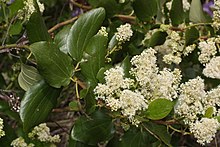Ceanothus velutinus, with the common names snowbrush ceanothus, red root, tobacco brush, and sticky laurel,[1] is a species of shrub in the family Rhamnaceae. It is native to western North America from British Columbia to California to Colorado.
| Ceanothus velutinus | |
|---|---|

| |
| Scientific classification | |
| Kingdom: | Plantae |
| Clade: | Tracheophytes |
| Clade: | Angiosperms |
| Clade: | Eudicots |
| Clade: | Rosids |
| Order: | Rosales |
| Family: | Rhamnaceae |
| Genus: | Ceanothus |
| Species: | C. velutinus
|
| Binomial name | |
| Ceanothus velutinus | |
Description
editCeanothus velutinus grows up to 4 metres (13 feet) tall but generally remains under three, and forms colonies of individuals which tangle together to form nearly impenetrable thickets.[2] The aromatic evergreen leaves are alternately arranged, each up to 8 centimetres (3 inches) long. The leaves are oval in shape with minute glandular teeth along the edges, and shiny green and hairless on the top surface.
The plentiful inflorescences are long clusters of white flowers. The fruit is a three-lobed capsule a few millimeters long which snaps open explosively to expel the three seeds onto the soil, where they may remain in a buried seed bank for well over 200 years before sprouting.[2] The seed is coated in a very hard outer layer that must be scarified, generally by wildfire, before it can germinate.[2] Like most other Ceanothus, this species fixes nitrogen via actinomycetes in its root nodules.[2]
Distribution and habitat
editCeanothus velutinus is native to western North America from British Columbia to California to Colorado, where it grows in hills and mountains in several habitat types including open coniferous forest and chaparral, often in rocky soils.[3]
Uses
editDeer and elk browse the plant during winter.[4]
Some Plateau Indian tribes drank a boil of this plant to induce sweating as a treatment for colds, fevers, and influenza. Leaves were also used when rinsing to help prevent dandruff.[5]
Ceanothus velutinus was known as "red root" by many Native American tribes due to the color of the inner root bark, and was used as a medicine for treating lymphatic disorders, ovarian cysts, fibroid tumors, and tonsillitis.[citation needed]
References
edit- ^ "Snowbrush, Ceanothus velutinus". Native Plants PNW. 30 November 2015. Retrieved 16 December 2023.
- ^ a b c d Forest Service Fire Ecology
- ^ "The Jepson Herbarium".
- ^ Fagan, Damian (2019). Wildflowers of Oregon: A Field Guide to Over 400 Wildflowers, Trees, and Shrubs of the Coast, Cascades, and High Desert. Guilford, CT: FalconGuides. p. 80. ISBN 978-1-4930-3633-2. OCLC 1073035766.
- ^ Hunn, Eugene S. (1990). Nch'i-Wana, "The Big River": Mid-Columbia Indians and Their Land. University of Washington Press. p. 352. ISBN 0-295-97119-3.
External links
edit- Jepson Manual Treatment - Ceanothus velutinus
- USDA Plants Profile: Ceanothus velutinus
- Ceanothus velutinus - Photo gallery